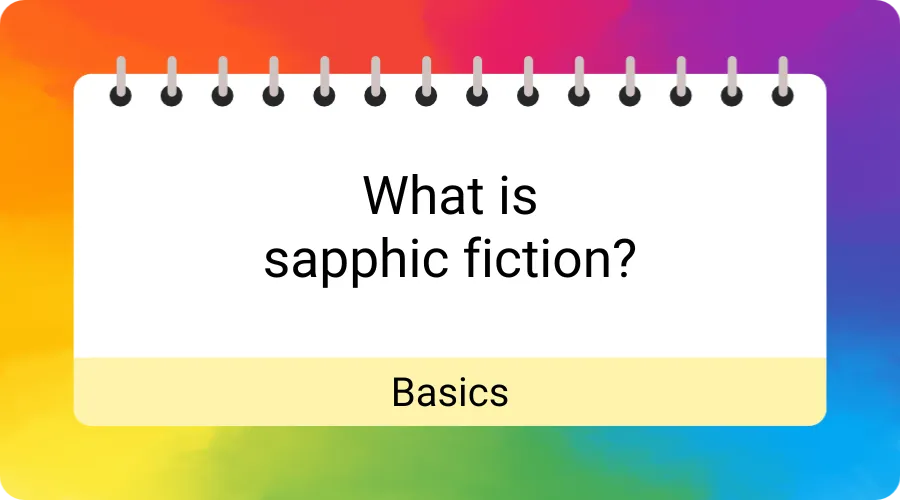In my last post, I talked about the term sapphic and why it has become more popular when referring to our category of books.
But which books are included in that category? What makes a book sapphic? Is it the identity of its author? Or maybe its intended audience? Or are the characters or their relationship the defining factor?
Let’s take a look a closer look at each question.
Is sapphic fiction defined as books written by sapphic authors?
I’ll write more about this question in a later post. For now, just let me sum it up by saying that while the majority of sapphic books are written by women-loving women, there are also sapphic books written by straight women, trans men, and cis men. For some authors, we simply don’t know whether they identify as lesbian/queer/sapphic, and I believe no author should be forced to publicly declare their sexual orientation and gender identity.
Sapphic authors are also, of course, writing books that have nothing to do with sapphic characters or themes. I know some people disagree, but personally, I would not consider a book sapphic just because it has been written by a sapphic author. If I decided to write a novel from the point of view of a straight protagonist, without any sapphic content, why would it be considered sapphic fiction?
So to me, defining sapphic fiction by the identity of the author doesn’t make any sense.
Is sapphic fiction defined as books written for a sapphic audience?
I’ll take a closer look at who reads sapphic fiction in a later post, but it probably won’t surprise you to hear that it’s mostly women-loving women. Let’s face it, most cishet readers probably wouldn’t go out of their way to read a lot of sapphic fiction.
But I wouldn’t say that sapphic fiction is written exclusively for sapphic readers. Anyone can—and in my totally biased opinion should—read sapphic books. From feedback emails, I know that I have readers of any gender and sexual orientation. This week, I had an email from a straight woman who told me she reads sapphic romance because it, in general, portrays more healthy relationships. I certainly wouldn’t want to exclude people like her from my readership.
Is sapphic fiction defined as books featuring sapphic characters?

To me, what makes a book sapphic is first and foremost its protagonist. At least one of the main characters has to be a sapphic woman or nonbinary person, and the story has to be written from the sapphic character’s point of view.
If the only sapphic person in the story is a supporting character, e.g., the protagonist’s lesbian best friend, the book doesn’t qualify as sapphic fiction.
The protagonist also has to be sapphic on the page. If the writer doesn’t even hint at the character’s sapphic identity within the book, but later mentions in an interview that they view the character as a women-loving woman or nonbinary person, I wouldn’t consider the book sapphic fiction.
Basically, it’s about meaningful on-page representation.
Is sapphic fiction defined as books featuring a sapphic relationship?
As in “mainstream” fiction, romance is by far the best-selling, most popular genre within sapphic fiction. But not every sapphic book is a romance. Although labeling a book “lesbian” or “sapphic” often comes with certain expectations, sapphic fiction can be any genre.
A mystery with a lesbian detective is considered sapphic fiction, and so is an urban fantasy novel about a bisexual witch. Even if the characters are single, that doesn’t change their sexual orientation. In an authentically written book, the protagonist’s queerness will still influence how they view the world and interact with it.
The book’s status as sapphic fiction doesn’t depend on whether there’s a romance subplot or an established sapphic relationship.
That said, if there is a romance in the book, it will be between two (or more) women or nonbinary people. If the happily ever after is between a man and a (bi- or pansexual) woman, it’s usually labeled queer M/F, not sapphic.
What about F/F erotica written through and for the male gaze?
Are steamy stories in which two women have hot sex, written by heterosexual men for heterosexual men considered sapphic fiction?
The answer is up for debate, but to me, they are an entirely different category.
Yes, I said sapphic fiction isn’t defined by who wrote it or who reads it. I stand by that. But I also said the story has to be written from the sapphic character’s point of view. Many male authors do a credible job with that. They write women-loving women who feel authentic instead of writing caricatures and stereotypes. I would absolutely classify their stories as sapphic fiction.
However, a story that fetishizes and objectifies women is clearly not written from a sapphic perspective, so by my definition, it’s not sapphic fiction. Sapphic fiction is all about the representation of queer women and sapphic people in a positive, respectful, and authentic way.
Summary
In short, I would define sapphic fiction by the sexual and/or romantic orientation of the point of view character, regardless of the identity of the author or audience. The deciding factor is respectful on-page representation of sapphic women and nonbinary characters.
What do you think?
What constitutes a sapphic book for you?
Feel free to disagree with my definition, as long as you are respectful about it.



